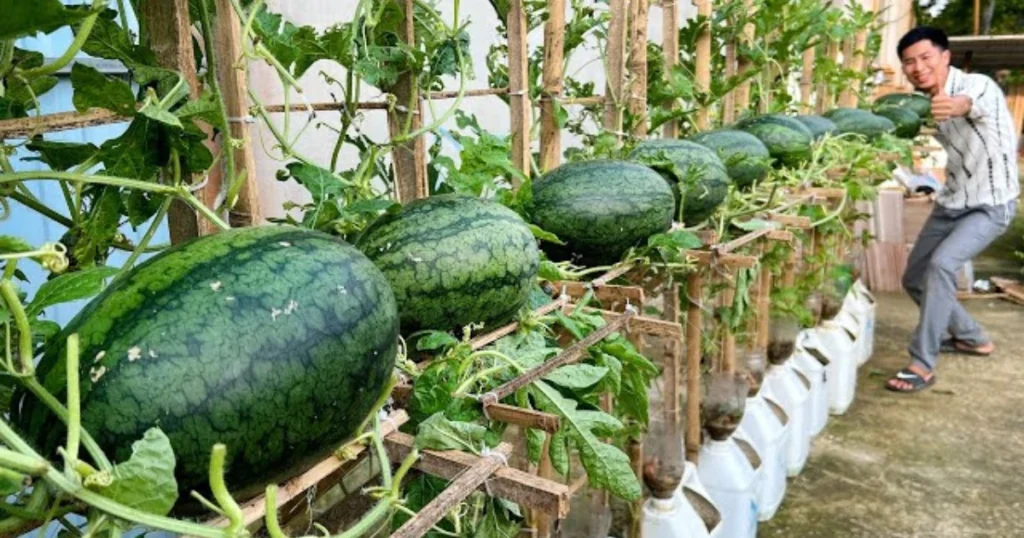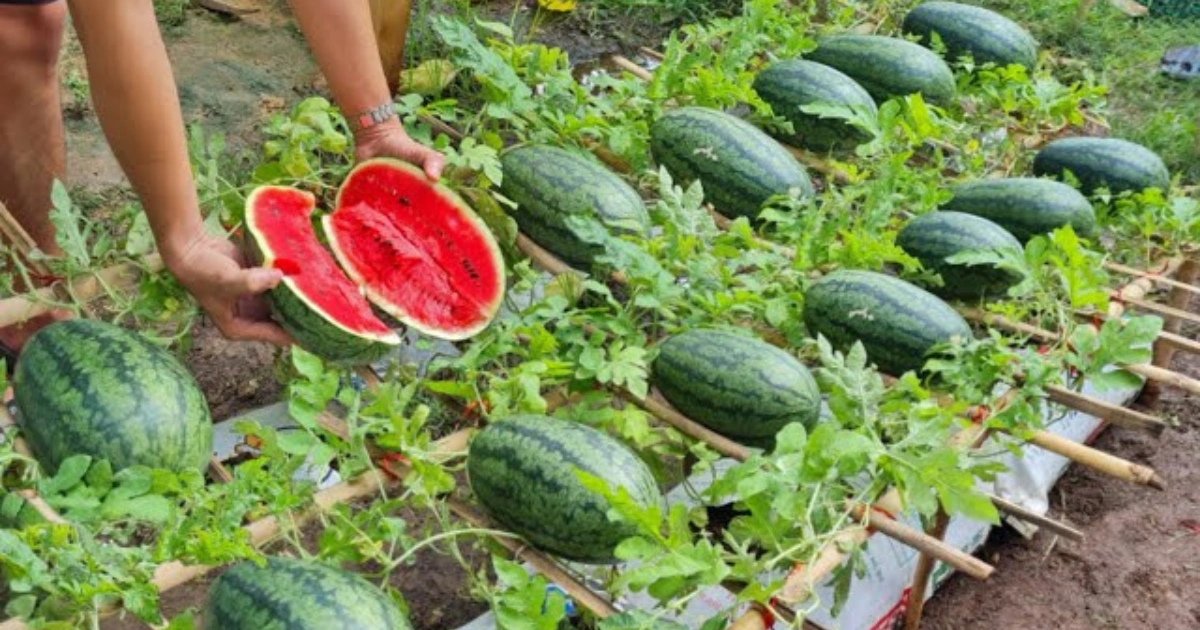Growing watermelons in containers is an excellent solution for gardeners with limited space or urban dwellers without a traditional backyard. With proper planning and care, you can enjoy sweet, homegrown watermelons even from a balcony or patio. This guide provides everything you need to successfully cultivate watermelons in pots—no garden required.

Why Grow Watermelons in Containers?
Container gardening allows more control over soil quality, moisture levels, and pest prevention. It also reduces the need for weeding and allows you to grow crops in small or temporary spaces. Watermelons, while known for their sprawling nature, can adapt well to pots if you choose the right variety and follow the appropriate care routine.
Choosing the Right Container
Watermelons need room for roots to spread and develop large fruits. Select a container that holds at least 5 gallons of soil—larger is even better. Ensure the container has drainage holes to prevent water from accumulating and causing root rot.
Ideal container options:
- Heavy-duty plastic or resin pots
- Fabric grow bags
- Half-barrels
- Large buckets with drainage holes
The Best Soil Mix for Potted Watermelons
Avoid using regular garden soil, as it tends to compact in containers, limiting airflow and drainage. Instead, fill your pot with high-quality potting mix or a soilless blend designed for vegetables.
Recommended soil components:
- Organic compost
- Coco coir or peat moss
- Perlite or vermiculite for drainage
Aim for a light, well-aerated mix that retains moisture without becoming soggy.
Watermelon Varieties That Thrive in Pots
Not all watermelon types are suitable for container growing. Choose compact or dwarf varieties that produce smaller fruits and require less space.
Top watermelon varieties for containers:
- Sugar Baby
- Golden Midget
- Jade Star
- Yellow Doll
- Mini Love
- Orange Sweet
- Queen of Hearts
- Jubilee (best in larger containers)
- Crimson Sweet (space-efficient when trellised)
These varieties are more manageable in small spaces and mature faster, making them ideal for urban gardening.
How to Plant Watermelons in Pots
You can either sow watermelon seeds directly into the container or transplant seedlings. Ensure the risk of frost has passed and soil temperatures are consistently above 65°F (18°C).
Steps to plant watermelons:
- Moisten the soil mix before filling the pot.
- Plant seeds about three times deeper than their diameter.
- If using seedlings, transplant carefully to avoid disturbing the roots.
- Space plants appropriately—ideally one plant per pot to avoid overcrowding.
Position your containers in a sunny area where the plants will receive at least 6 to 8 hours of direct sunlight daily.
Essential Watermelon Care Tips
Watermelons are heavy feeders and require regular maintenance to thrive in containers. Follow these tips to ensure optimal growth:
Watering
- Water deeply and regularly to keep the soil evenly moist.
- In cooler temperatures (below 80°F or 27°C), once per day may be enough.
- In hotter climates, water twice daily—morning and late afternoon.
Feeding
- Use a water-soluble fertilizer designed for fruiting plants once a week.
- Alternatively, apply a balanced slow-release granular fertilizer monthly.
- Avoid high-nitrogen fertilizers, which encourage leafy growth over fruiting.
Supporting the Vines
Since watermelons produce trailing vines, support structures are essential in containers:
- Use a sturdy trellis to train vines upward and save space.
- As fruits begin to form, create slings or hammocks using cloth or netting to cradle them and prevent stem damage.
- Rotate the container occasionally to ensure even sunlight exposure.
Harvesting Watermelons in Pots
Most container-friendly watermelon varieties are ready to harvest within 70 to 90 days after planting. Signs your watermelon is ripe include:
- A dull, hollow sound when tapped
- The tendril closest to the fruit turns brown and dries up
- The bottom spot (where the melon rests) turns creamy yellow
Use garden shears or a sharp knife to cut the fruit from the vine without damaging the plant.
Frequently Asked Questions
Can I grow watermelons on a balcony or rooftop?
Yes. As long as the plants receive enough sunlight and you use a large enough container with proper drainage, you can grow watermelons successfully on balconies, rooftops, or patios.
How many watermelons can one plant produce?
Container-grown watermelon plants typically yield one to three fruits per vine, depending on the variety and care.
Should I prune watermelon vines in containers?
Yes. Pruning secondary vines can help redirect the plant’s energy toward developing larger fruit. Remove any damaged or unnecessary vines.
Can watermelons be grown indoors?
Watermelons need full sun and significant space, so they are best grown outdoors. However, a greenhouse or sunny sunroom may provide enough light if conditions are right.
What pests should I watch out for?
Common pests include aphids, spider mites, and cucumber beetles. Use organic insecticidal soap or neem oil as needed, and inspect plants regularly.
Related Articles from secretsofthegreengarden.com
- How to Grow Ginger in Plastic Bags for a Massive Yield
- The Best Root Vegetables for Container Gardening
- How to Grow Garlic Without a Garden
Recommended External Resources
- University of Illinois Extension – Growing Watermelons
https://extension.illinois.edu/gardening/growing-watermelons - Almanac – Watermelon Growing Guide
https://www.almanac.com/plant/watermelons - University of California Master Gardener Program – Watermelon Tips
https://ucanr.edu/sites/mgfresno/Gardening_Tips
Conclusion
You don’t need sprawling land or a large backyard to enjoy fresh, juicy watermelons. With the right container, soil, and care techniques, anyone can grow watermelons in pots—even on a balcony. Choose compact varieties, water consistently, and give your plants the support they need to thrive. Before you know it, you’ll be harvesting delicious melons straight from your container garden.


https://t.me/s/official_1win_aviator/59
https://t.me/s/official_1win_aviator/405
https://t.me/official_1win_aviator/582
https://t.me/Best_promocode_rus/2031
https://t.me/s/ef_beef
https://t.me/s/officials_pokerdom/3309
برای دوستانی که به دنبال یک راهکار مطمئن برای وریفای حساب در بروکرهای فارکس هستند، پیشنهاد میکنم خدمات شوپی را بررسی کنند. این مجموعه به صورت تخصصی، وریفای قانونی حساب های فارکس را با مدارکی ارائه میدهد که کاملاً معتبر بوده و به نام خودتان صادر میشود. این روش دائمی است و ریسک بلاک شدن حساب شما را به صفر میرساند. کیفیت و پشتیبانیشان واقعاً عالی است.
https://t.me/s/ezcash_officials